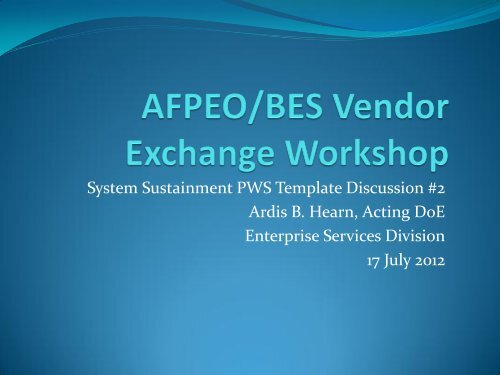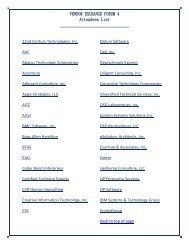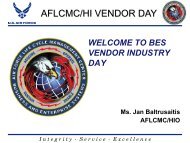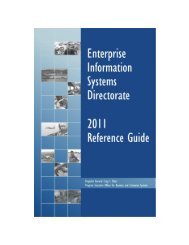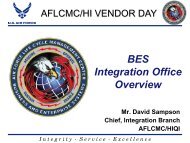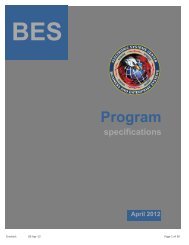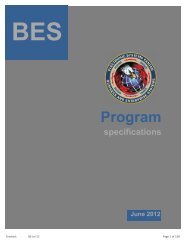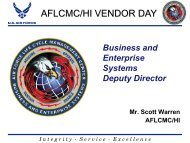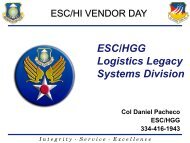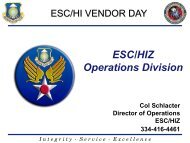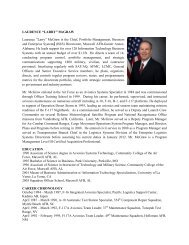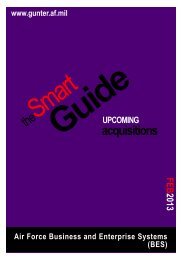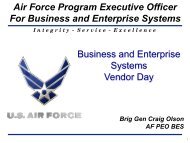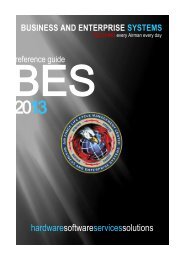Performance Work Statement (PWS)
Performance Work Statement (PWS)
Performance Work Statement (PWS)
You also want an ePaper? Increase the reach of your titles
YUMPU automatically turns print PDFs into web optimized ePapers that Google loves.
System Sustainment <strong>PWS</strong> Template Discussion #2<br />
Ardis B. Hearn, Acting DoE<br />
Enterprise Services Division<br />
17 July 2012
I’d love to see<br />
the <strong>PWS</strong> on<br />
this one!<br />
2
Purpose/Objectives<br />
• Clarify the role of the Template<br />
• Provide Summary of Feedback from<br />
<strong>Work</strong>shop#1<br />
• Discuss Feedback Topics<br />
• Identify areas to continue to work<br />
• Discussion/Q&As<br />
3
Role of the template<br />
ID/IQ Level <strong>PWS</strong> Templates – USAF<br />
• Instructions Provided<br />
• Details must be inserted<br />
• Tailorable – only applicable requirements, deliverables,<br />
performance measures remain<br />
• Deliverables/<strong>Performance</strong> Measurements/Standards in Guide<br />
• Certifications cannot be higher than ID/IQ<br />
Organizational Specific Templates – PEO<br />
• Add more details on filling in requirements, deliverables,<br />
performance measures, evaluation approach, etc<br />
• Each requirement will be worked/tailored by individual<br />
program MFT<br />
4
Summary of feedback<br />
Clearly define requirements<br />
• Context/Background<br />
• System scale/scope/priorities/artifacts<br />
• Use cases/Architectures (As-Is and To-Be)<br />
• Deliverables/CLINS/Contract Type<br />
• <strong>Performance</strong> Measures<br />
Send out Draft RFPs<br />
Improve Communication between Vendors & MFT<br />
Provide Basis of Estimate Information/Tools<br />
RFP Process Suggestions<br />
5
Discussion Items<br />
Clearly define requirements & scope/scale of work<br />
“As-Is” and “To-Be” (if applicable)<br />
Architecture Views, Use-Cases, Detailed Information<br />
(number of screens/inputs, database tables, keys, code info,<br />
reports, etc)<br />
Separate Functional from Non-Functional (System)<br />
Requirements<br />
Provide more context per requirement<br />
• Requirement priority<br />
• Requirement objective<br />
• Stakeholder affected<br />
6
Discussion Items<br />
Clearly define requirements & scope/scale<br />
of work<br />
More initial Background Information<br />
Top down Context starting with Mission perspective<br />
Customer’s Vision/Objectives<br />
Strategy<br />
Governance<br />
Stakeholders<br />
Environment<br />
7
Discussion Items<br />
Clearly define requirements & scope/scale of<br />
work<br />
• Innovation vs. Risk Trade-Space – Industry cannot effectively<br />
consider potential innovation until all the above is thoroughly<br />
understood. We recommend Government provide the following to<br />
assist Industry consideration for innovation:<br />
• Innovation Focus Areas – What areas does the customer hope to<br />
achieve innovations and what are their priority of desire<br />
• Risk Table – one cannot propose innovation without considering<br />
risk. Government should provide their assessment of risk areas<br />
so Industry can propose appropriate innovations. The following<br />
table should be provided for each TO RFP:<br />
Risk Concern Customer’s Risk Tolerance (high,<br />
medium, low)<br />
8
Discussion Items<br />
CLINS – The issue is ensuring the Task Order uses the right contract type. Fixed<br />
Price is the preferred type. The guidance for the CLIN structure is clearly provided in<br />
the User’s Guide. Provide B tables if applicable.<br />
Base Period<br />
(3-yr)<br />
Option<br />
Period 1 (1-<br />
yr)<br />
Option<br />
Period 2 (1-<br />
yr)<br />
Option<br />
Period 3 (1-<br />
yr)<br />
Option<br />
Period 4 (1-<br />
yr)<br />
Description<br />
Pricing<br />
0010 1010 2010 3010 4010 Network Centric<br />
Solutions<br />
Firm Fixed Price<br />
(FFP)<br />
0020 1020 2020 3020 4020 Network Centric Cost<br />
Solutions<br />
0030 1030 2030 3030 4030 Network Centric Labor Hour (LH)<br />
Services<br />
0040 1040 2040 3040 4040 Data Firm Fixed Price<br />
(FFP)<br />
0050 1050 2050 3050 4050 Warranty Firm Fixed Price<br />
(FFP)<br />
0060 1060 2060 3060 4060 Other Direct Costs Cost<br />
(ODC)<br />
0070 1070 2070 3070 4070 Travel Cost<br />
0080 1080 2090 3090 NetCents-2 Post Award<br />
Conference<br />
Firm Fixed Price<br />
(FFP)<br />
2080** 3080** Small Business<br />
Graduate Data<br />
Submission<br />
Included in CLIN<br />
2010, 2020, 2030,<br />
3010, 3020 or 3030<br />
9
Discussion Items<br />
DIDs/CDRLs– Instructions in User’s Guide.<br />
Sequence<br />
Number<br />
Data Item<br />
Description<br />
Title<br />
A027 DI-IPSC-81427A Software Development Plan (SDP)<br />
A028 DI-IPSC-81428A Software Installation Plan (SIP)<br />
A029 DI-IPSC-81429A Software Transition Plan (STRP)<br />
A030 DI-IPSC-81430A Operational Concept Description (OCD)<br />
A031 DI-IPSC-81431A System/Subsystem Specification (SSS)<br />
A032 DI-IPSC-81432A System/Subsystem Design Description (SSDD)<br />
A033 DI-IPSC-81433A Software Requirements Specification (SRS)<br />
A034 DI-IPSC-81434A Interface Requirements Specification (IRS)<br />
A035 DI-IPSC-81435A Software Design Description (SDD)<br />
A036 DI-IPSC-81436A Interface Design Description (IDD)<br />
A037 DI-IPSC-81437A Database Design Description (DBDD)<br />
A038 DI-IPSC-81438A Software Test Plan (STP)<br />
A039 DI-IPSC-81439A Software Test Description (STD)<br />
A040 DI-IPSC-81440A Software Test Report (STR)<br />
A041 DI-IPSC-81441A Software Product Specification (SPS)<br />
A042 DI-IPSC-81442A Software Version Description (SVD)<br />
A043 DI-IPSC-81443A Software User Manual (SUM)<br />
A044 DI-IPSC-81444A Software Center Operator Manual (SCOM)<br />
10
Discussion Items<br />
<strong>Performance</strong> Measures – Industry best practices listed in User’s Guide for customer<br />
to select from/tailor if applicable. Here are additional from <strong>Work</strong>shop Feedback:<br />
Legacy systems are sustained without periods of prolonged degradation<br />
Complex software problems are isolated and resolved<br />
Backlog of deficiencies do not exceed an average of XX (for example pick an<br />
appropriate number such as 50 for that particular project) between releases.<br />
Mean time to assess (MTTA) and mean time to repair (MTTR) for deficiency<br />
reports. Choose an appropriate number for each for the project such as 24<br />
hours for category 1, 48 for category 2, etc. and something like 3 business<br />
days MTTR for category 1, 15 business days for category 2, and so on.).<br />
Defect density of repaired code delivered for deficiency repairs and<br />
enhancements from BCRs. This should be expressed in average defects<br />
per FP or KSLOC.<br />
Improvement and technology refresh of the application. This should be<br />
expressed in percentage of defect density improvement for code and<br />
reduction in maintainable code for using new technologies such as code<br />
generators.<br />
Application enhancement performance. This should be expressed in new<br />
Function points delivered and function points touched for BCR<br />
improvements.<br />
Monthly Review<br />
Monthly Review<br />
Monthly Review<br />
Monthly Review<br />
Monthly Review<br />
Monthly Review<br />
Monthly Review<br />
11
Discussion Items<br />
Send out Draft RFPs<br />
• Have a stakeholder meeting to draft RFP release to gain solid understanding of<br />
requirements –Government could have an Industry Day with Q&A open to all<br />
potential bidders – suggest after DRFP and before final RFP<br />
• Do not cut off discussions until final RFP is sent—Government must share<br />
information with all potential bidders so discussions cannot be totally free and<br />
informal<br />
Improve Communication between Vendors & MFT<br />
• Establish a website for collaboration on the requirements<br />
• Allow anonymous chat<br />
• Would also be helpful if bidder's libraries were consistently made available<br />
during the draft RFP stage<br />
• Utilize a more efficient system of record to handle, store and distribute<br />
RFP/RFQ opportunities.<br />
• If a system such as AFWay were to be used, it would be helpful for a more<br />
descriptive RFP/RFQ name– Agree and Instructions are in User’s Guide<br />
12
Feedback From 1 st <strong>Work</strong>shop<br />
Provide Basis of Estimate<br />
• Having a clearly defined BOE will reduce risk and reduce overall price. It<br />
would be helpful if the Government would provide the following to assist<br />
offerors development of their solutions, BOE and ultimate price:<br />
• Effective sizing metrics—SLOC, FPs, Complexity, etc<br />
• Government Independent Cost Estimate (ICE) assumptions—Share<br />
assumptions on what tools/licenses/operational environment used<br />
• The Government ICE when possible—Did not know this was ever possible;<br />
have seen budgets/funding provided in <strong>PWS</strong><br />
• If Government ICE cannot be provided, identify the specific tools utilized<br />
to develop the ICE<br />
13
Feedback From 1 st <strong>Work</strong>shop<br />
RFP Process Suggestions<br />
• When posting efforts, bidders are more responsive when something is out for<br />
bid for 3-5 weeks. The size and scope will drive the complexity of the bid but if<br />
industry has a 2-3 week period to bid, it is possible that we will not have time to<br />
pull a competitive bid together<br />
Suggestion on format: Recommend the Government issue RFPs in editable<br />
PDF and in native format (word, excel) so vendors can allocate the elements of<br />
the RFP to the right team members . When documents are scanned, they are<br />
rendered as images vice text. This format makes it harder for industry to<br />
handle and delays response.<br />
14
Feedback From 1 st <strong>Work</strong>shop<br />
All of these are addressed in the User’s Guide and are tailorable:<br />
Additional Information: Suggest the following information also be<br />
included with RFP release:<br />
Training/Certification requirements<br />
DoD 8570.01-M requirements<br />
<strong>Work</strong>load projections (projected labor hours or FTEs)<br />
Government Furnished Equipment/Items (GFE/GFI)<br />
Any DoD or Air Force relevant guidance<br />
Available requirements documents (i.e., CONOPS, VDD, CDD,<br />
etc.)<br />
Security requirements (include Draft DD Form 254 as required)<br />
15
Challenges<br />
<br />
<br />
<br />
<br />
<br />
<br />
Keeping up with IT Policies/Guidance over time<br />
Making this a template that a user has to think through and<br />
document individual requirements and not just take it<br />
whole<br />
Giving enough information so that contractors can gauge<br />
the scope/scale of the effort so it can be priced—but not so<br />
much that there is no discrimination and all proposals are<br />
exactly the same<br />
Making sure it is performance based to a level that makes<br />
sense<br />
Requiring appropriate types and amounts of deliverables<br />
Ensure the system can be sustained by any qualified<br />
contractor<br />
Ensuring all compliance guidance is complete and clear 17
Questions<br />
18


